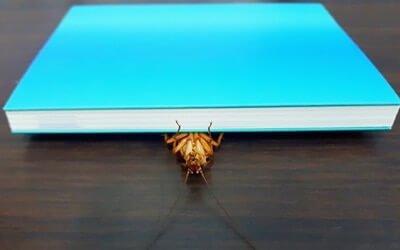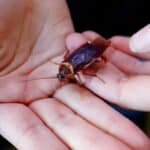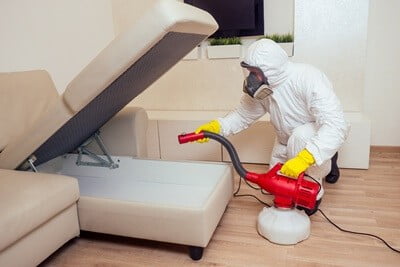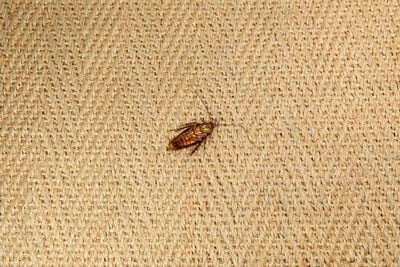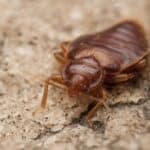When you have cockroaches, it feels like nothing in the home is safe. Roaches can hide just about anywhere that’s warm, dark, and quiet. Books and bookcases provide a convenient place for cockroaches to hide and rest.
Roaches can live in books because they make a good hiding place. Books are a rich source of starch, which cockroach saliva turns starch into glucose. A book’s glue, bindings, and cover are all edible foods.
Dealing with roaches inside the home isn’t easy because they get everywhere. Unfortunately, books, like many other household items, are food sources, making them hard to protect when there’s an infestation.
Do Cockroaches Hide In Books?
Roaches are unlikely to live inside books. Instead, they usually visit them for food before heading back to a more permanent home. If cockroaches can’t find a more suitable place to live, they will hide behind a bookshelf or bookcase to avoid being seen by predators.
Some cockroaches also like the smell of books, especially when there are lots of them. It indicates that food is available. However, if your books or bookcase are in constant use, roaches may deem the area unsafe and flee, only coming back at night when it’s dark and quiet.
Similarly, stacks of newspapers, magazines, and books make a great hiding space. Not only do they provide an abundant source of food, but they provide opportunities for roaches to crawl into the gaps and live amongst the books and paper undetected.
Keeping your books and paper-based items upright makes it harder for cockroaches to set up a home in them. Wedging them tightly in between bookends also prevents roaches from squeezing into the smallest gaps.
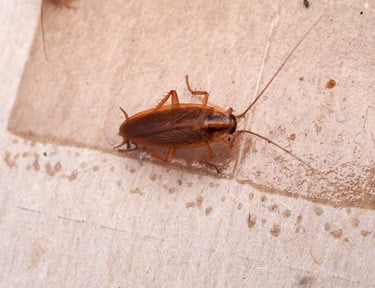
Do Cockroaches Eat Books?
Books might not be the first thing you think of when you consider what a cockroach might eat, but roaches will eat anything digestible. As discussed, books and paper are good sources of starch.
Cockroaches can digest cellulose, allowing them to eat paper and glue. Large roaches have strong chewing mandibles that allow them to tear off book covers and paper to eat.
Signs That A Cockroach Has Eaten Books
A book that’s been eaten by cockroaches will have ragged edges, holes, and bite marks. Depressions in the paper may also occur. At a distance, the damage looks like mold. When looked at close up, a book that’s been eaten will appear puckered with roach bites.
You might also observe damage to your books’ covers and spines. For books with a cloth or leather cover, cockroaches remove the top layer and break down the fibers, destroying the books entirely.
As well as noticeable bite marks and holes, there are other obvious signs of cockroaches eating books. This includes pelletized feces on or around the books. The feces are distinctive in shape and match the color of the book the cockroaches have eaten.
Eaten books will also have traces of attar on them. Attar is a brown liquid that roaches regurgitate when eating. It contains pheromones that attract other cockroaches to the food source. As described by The Journal of Allergy and Clinical Immunology, roaches regurgitate digestive juices that appear as brown stains.
Do Cockroaches Lay Eggs In Books?
Cockroaches don’t lay multiple eggs. They lay a large, single sack called an ootheca. An ootheca has a tough outer casing that protects the eggs. Hatching takes place within 3 to 6 months.
A female roach’s primary goal is to hatch her eggs to continue the colony. She will lay them anywhere she deems safe, preferring dark, quiet areas that no one else knows about.
Books fit the bill if they’re tucked away from harm – in a garage or loft, for example. However, cockroaches aren’t likely to lay their eggs inside books because they’re hard to get inside. Instead, they will lay them along the book’s spine or the fore-edge, which is the vertical edge that’s opposite the spine.
Similarly, if she successfully manages to hatch the eggs in a spot where books are located, she will go back there once she’s ready to lay more. This is because she knows the books are a safe place to hatch her young.
Cockroaches can go through many breeding cycles without you knowing. Female roaches produce around 16 cockroaches at a time and between 6 to 14 ootheca in her lifetime.
How To Clean Books from Cockroaches
If roaches have left smears or feces over your books, you must clean off as much as you can. Roach excrement appears as brown spots and most commonly occurs on the fore edge, which is opposite the spine.
It’s tricky, if not impossible, to remove roach residue from paper pages once the stains have seeped through. However, you can make them look better. The book’s exterior is also usually salvageable. At the very least, all books should be sanitized to stop harmful roach pathogens from making you ill.
If the books are old or delicate, take care not to ruin them. Books that mean a lot to you should be taken to a preservationist. For all other books, this DIY cleaning method is effective. You will need the following:
- Soft brush
- Artist’s gum eraser
- Cotton swab
- Household bleach
- Fine sandpaper
- Soft cloth
- Lighter fluid
- Leather conditioner
Here’s what to do:
- Clear loose excrement from the book using a soft brush, holding the book tightly closed.
- Use the artist’s gum eraser to remove feces and stains. Keep holding the book tightly to protect the pages.
- Use a cotton swab and dip it in the bleach, being careful not to saturate the cotton. Dab it onto the stains.
- Open the book and find the stained pages. Dab any stains you see with the bleach-covered cotton ball. Let each page dry before continuing.
- If the beach treatment hasn’t worked, use fine sandpaper to sand the stains off the book’s exterior. Don’t attempt this technique on the pages.
- For books with a glossy dust jacket, rub the stains with a damp cloth dipped in lighter fluid.
- If your book has leather bindings, clean them with the damp cloth that’s been dampened with lighter fluid and use a leather conditioner to buff it.
After these steps, your book won’t be perfect, but it will be clean, stain-free, and sanitized.
How To Keep Cockroaches Away from Books
When roaches threaten your books, you’ll want to protect them so that you can keep them on show. It’s essential that the remedies you choose are safe to use around books, especially those that are old and delicate. Thankfully, there are natural home remedies that you can use to keep cockroaches away from your possessions:
Catnip
Cockroaches loathe catnip. A study reported by Science Daily found that placing catnip around the home keeps German cockroaches away. Specifically, roaches are repelled by nepetalactone – the chemical found in the catnip plant.
To keep roaches away, sprinkle catnip in various spots within your bookcase or on your books. Alternatively, you can create homemade sachets with dried catnip inside. Or, for a more potent concoction that works more quickly, brew catnip tea and leave it near your books.
Boric Acid
Sprinkling boric acid around your books is an effective way to deal with roaches. Also, you can make a tempting bait by mixing boric acid, flour, and sugar. The sugar attracts roaches and encourages them to eat the dough.
Once consumed, the boric acid will poison the roach. Many cockroaches see their dead kin as an opportunity for food and feast on the poisoned roach, eventually killing the entire colony. While boric acid is effective, some homeowners find it too toxic to use in the home when they have young children or pets.

Diatomaceous Earth
Diatomaceous Earth is a naturally occurring sand that kills cockroaches due to its sharp edges. The edges penetrate a cockroach’s exoskeleton, absorbing its essentials oils and fats and killing it due to dehydration. Diatomaceous Earth can be sprinkled near books without causing damage. After a couple of days, sweep it away and replace it.
Soapy Water
If you find cockroaches crawling around your books, you can kill them quickly with liquid soap and water. Mix some soap in a spray bottle with warm water and spray it directly at any roaches you find. 2-3 squirts should suffice. The solution works by covering a roach’s breathing pores, suffocating it.
Plastic Containers
If you’re dealing with a larger infestation, you might want to pack your books into plastic storage boxes until you’ve dealt with the problem. Roaches that are left to roam will head towards your books for food. While you won’t want to leave your books in these boxes forever, it will protect them until the infestation is eradicated.
Don’t pack your books into cardboard boxes, as cockroaches will eat through the cardboard. Roaches gain sustenance through cardboard and the glue that binds boxes because both are made of starch.
Roaches will then get into the cardboard box and breed because of the darkness and warmth it provides, destroying your books in the process. Roaches can’t get into plastic containers, nor will they eat plastic, keeping your books safe.
It’s uncommon for cockroaches to live in books. Books are commonly housed in high-traffic areas of the home that are too dangerous for cockroaches. Roaches will look for other food sources and hiding spots that are easier to get. If you’re finding cockroaches in books, you likely have a severe infestation.
